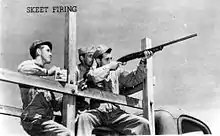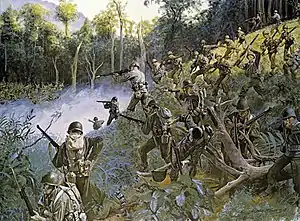| Arizona during World War II | |
|---|---|
 First Lady Eleanor Roosevelt and Dillon S. Myer visit the Gila River War Relocation Center (April 23, 1943) | |
| Location | Arizona, United States |
| Date | 1940–1945 |
| Casualties | ~2,349 |
| Events | Machita Incident – October 16, 1940 Thanksgiving Day /Phoenix Massacre – November 27, 1942 Great Papago Escape – December 23, 1944 |
The history of Arizona during World War II begins in 1940, when the United States government began constructing military bases within the state in preparation for war. Arizona's contribution to the Allied war effort was significant both in terms of manpower and facilities supported in the state. Prisoner of war camps were operated at Camp Florence and Papago Park, and there was an internment camp to house Japanese-Americans, most of them citizens, who had been forcibly deported from the West Coast.
The war years provided great economic stimulus, both because of the numbers of troops at camps in the state, and increase in demand, and the expansion of wartime demand for such materials as copper and other metals. Industries expanded, adding to the state's recovery from the Great Depression.
Hispanics
During the war, Mexican-American community organizations promoted efforts to support American troops abroad. They worked both to support the war effort materially and to provide moral support for young American men fighting the war, especially their young Mexican-American men from local communities. Some community projects were cooperative between Anglo and Hispanic communities, but most were localized within the Mexican-American community.[1] Mexican-American women also organized to assist their servicemen and the war effort; an underlying goal of Tucson's Spanish-American Mothers and Wives Association was the reinforcement of the woman's role in Spanish-Mexican culture. Members raised thousands of dollars, wrote letters, and joined in numerous celebrations of their culture and their support for Mexican-American servicemen. Membership reached more than 300 during the war. The organization stopped operating in 1976.[2]
Casualties
| County | Killed in Action (KIA) | Died of Wounds (DOW) | Died of Injuries (DOI) | Died, Non-Battle (DNB) | Finding of Death (FOD) | Missing in Action (MIA) | Total |
|---|---|---|---|---|---|---|---|
| Apache | 27 | 3 | 20 | 1 | 51 | ||
| Cochise | 68 | 8 | 24 | 10 | 1 | 111 | |
| Coconino | 31 | 14 | 4 | 49 | |||
| Gila | 47 | 12 | 21 | 7 | 87 | ||
| Graham | 31 | 4 | 12 | 1 | 1 | 49 | |
| Greenlee | 18 | 4 | 6 | 2 | 1 | 31 | |
| Maricopa | 277 | 35 | 161 | 40 | 1 | 514 | |
| Mohave | 9 | 2 | 9 | 2 | 22 | ||
| Navajo | 36 | 5 | 17 | 6 | 64 | ||
| Pima | 145 | 13 | 1 | 67 | 12 | 1 | 239 |
| Pinal | 66 | 15 | 32 | 2 | 115 | ||
| Santa Cruz | 28 | 1 | 13 | 1 | 43 | ||
| Yavapai | 47 | 4 | 22 | 7 | 80 | ||
| Yuma | 55 | 6 | 1 | 13 | 5 | 80 | |
| State at Large | 31 | 3 | 33 | 8 | 3 | 78 | |
| Total | 916 | 115 | 2 | 464 | 108 | 8 | 1613 |
| Type | Total |
|---|---|
| Killed in Action (KIA) | 27 |
| Killed in Prison Camps | 11 |
| Missing in Action (MIA) | 17 |
| Wounded in Action (WIA) | 41 |
| Released from Prison Camps | 17 |
| Total | 113 |
Prisoner of war camps
Arizona's Camp Florence, on the Florence Military Reservation, was the first permanent alien enemy camp constructed during World War II. Construction began during 1942 to house 3000 internees, with room to expand to 6000. The initial construction budget was $4.8 million. The United States did not detain numerous enemy aliens here, so the Army used Camp Florence as a POW camp.[5]
Gallery
 Eight Arizonans were killed aboard USS Arizona during the attack on Pearl Harbor.[6]
Eight Arizonans were killed aboard USS Arizona during the attack on Pearl Harbor.[6] The entrance to Williams Field in 1942.
The entrance to Williams Field in 1942. Two AT-6 Texans in flight near Luke Field in 1943.
Two AT-6 Texans in flight near Luke Field in 1943. Ira Hayes (Pima) seen here preparing to parachute out of an aircraft in 1943, was from Sacaton. He fought in many engagements in the South Pacific before becoming famous for raising the American flag on Mount Suribachi during the Battle of Iwo Jima.
Ira Hayes (Pima) seen here preparing to parachute out of an aircraft in 1943, was from Sacaton. He fought in many engagements in the South Pacific before becoming famous for raising the American flag on Mount Suribachi during the Battle of Iwo Jima. Italian prisoners of war work on the Arizona Canal in 1943.
Italian prisoners of war work on the Arizona Canal in 1943. B-25 Mitchell crewmen at Douglas Army Airfield in 1944.
B-25 Mitchell crewmen at Douglas Army Airfield in 1944. Skeet shooting at Kingman Field in 1944.
Skeet shooting at Kingman Field in 1944. The Hirano family, ethnic Japanese removed from California, were among thousands interned at the Poston War Relocation Center from 1942 to 1945.
The Hirano family, ethnic Japanese removed from California, were among thousands interned at the Poston War Relocation Center from 1942 to 1945. The Bushmasters during the Philippines Campaign in 1945.
The Bushmasters during the Philippines Campaign in 1945.
See also
References
- ↑ Christine Marín, "Mexican Americans on the Home Front: Community Organizations in Arizona During World War II," Perspectives in Mexican American Studies (1993) 4:75–92
- ↑ Julie A. Campbell, "Madres Y Esposas: Tucson's Spanish-American Mothers and Wives Association," Journal of Arizona History (1990) 31#2 pp: 161–182,
- ↑ "WWII Army Casualties: Arizona". Retrieved September 26, 2012.
- ↑ "WWII Casualties: Arizona". Retrieved September 26, 2012.
- ↑ George G. Lewis; John Mehwa (1982). "History of Prisoner of War Utilization by the United States Army 1776–1945" (PDF). Center of Military History, United States Army. Retrieved 16 August 2020.
- ↑ Melton, Brad; Dean Smith. Arizona Goes to War: The Home Front and the Front Lines during World War II. University of Arizona Press. ISBN 978-0816521906.
External links
 Media related to Arizona during World War II at Wikimedia Commons
Media related to Arizona during World War II at Wikimedia Commons
